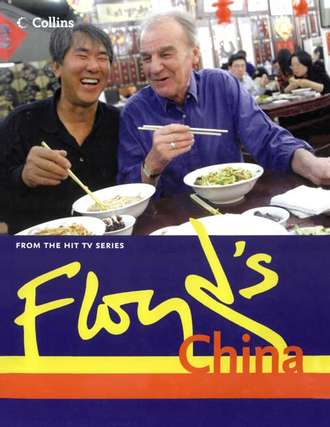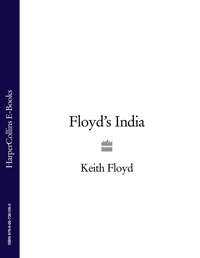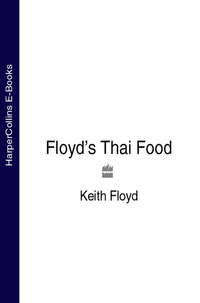
Полная версия
Floyd’s China
Basically there are two types of noodle dish. One is a plate of boiled noodles with pork or duck and some vegetables and accompanied with a cup of soup; the other, what we know as chow mein, are pan- or wok-fried noodles mixed with stir-fried meat, vegetables or seafood. But, most importantly, and this is why it is hard to really re-create Chinese food in a Western kitchen, especially if you happen to have a halogen hob electric cooker, the Chinese cookers and the woks that sit on them have such intense, instant, volcanic heat that things can be cooked very quickly, thus maintaining the flavours, vitamins and the healthiness of this food. If you enjoy stir-frying dishes, for an authentic flavour you may well be advised to buy a powerful camping gaz-type stove, a bottle of gas and cook it outside.
The Chinese love food – love buying it, discussing it and love to eat communally, whether at home or in a restaurant. Not for them a table for two – large round tables for 10, 15 or 20 are quite common. They also mostly use fresh ingredients, which can mean two trips a day to the market. And nothing is wasted – you name it, the Chinese will find a way to cook it, be it chicken’s feet, jellyfish or sea slugs. Not to mention the grilled insects, bird, frogs and snakes.
The cuisine is built around the five tastes: sweet, sour, bitter, pungent and salty, and on the techniques of steaming, braising, stir-frying, deep-frying, boiling and roasting. Fermentation is also used to produce sauces such as soy sauce – that quintessentially Chinese seasoning – and pickled ginger, salted black beans, and many more. Add to the equation a grain food – usually boiled or steamed rice – and you have the foundation for your Chinese meal.
Not surprisingly in a country as vast as China, there are four distinct regions, each with its own cooking style – northern/Peking; western/Sichuan; Eastern/Shanghai; and southern/Canton.
Back here, we have our Peking, Cantonese and Sichuan restaurants. Very broadly speaking, we have only to add Shanghai cuisine and we have the four gastronomic regions of China, each with its own peculiarities.
I started my journey in Beijing, or Peking as it was known, and Peking cuisine is that of the north. The main staple here is wheat – steamed bread and noodles are the most common produce, as well as the popular breakfast street food ‘youtiao’, mentioned earlier. An equally popular dish in the north is dumplings, stuffed with a variety of fillings, and eaten with a vinegar dip, soy sauce or what you fancy. The most famous dish has to be Peking Duck, so called because it was originally made with the special ducks bred near Peking. Other specialities of the north include chestnuts, Chinese cabbage, seafood (in Shandong province), offal and noodles, while the Chinese Muslims of the area are lovers of lamb and beef – the Mongolian beef hotpot on is a particular favourite. Oh yes, and they brew a very good beer called Tsingtao – great with dumplings!
To the east we find Shanghai cuisine. A land of lakes, canals and rivers, the region is abundant in both fresh- and seawater fish, as well as rice, wheat and corn. It’s where they make the famous Shaoxing (Shaohsing) rice wine, and wine features in many dishes of the area, as does oil, fat and sugar, giving the cuisine a style of its own. Red-braised dishes are a well-known speciality, as are stir-fried eel and crab, shrimp, prawn and fish dishes.
Cantonese, or southern cuisine, is the most versatile of the four, as well as the lightest – less oil, sugar, garlic, chilli and seasoning are used than in the other cuisines. But what it lacks in strong flavours, it makes up for in subtleness of flavour and texture – crisp is very crispy, smooth is very smooth. Stir-frying excels here, and we have this region to thank for dim sum – that vast variety of Chinese ‘hors d’oeuvres’ enjoyed at breakfast and lunch. Each area throughout this region has its own specialities, be it chicken, tripe, mustard greens, seafood or soups, but given their sub-tropical climate, they all enjoy a wide variety of tropical fruits, the lychee being the most abundant. And by the way, if you like snake, this is the place to come to eat it.
Lastly, we have Sichuan, or western cuisine, whose food is mainly hot and spicy. Sichuan peppercorns and red chillies are used extensively to add intensity to the dishes, as are garlic, ginger and salt. The west is a landlocked area and to compensate for the lack of fresh fish, a fermented fish sauce is added to many dishes, which also feature a variety of shapes and tastes. Here is to be found more varieties of edible fungi than in any other province of China. It’s also the home of Maotai wine – not a wine, in fact, but a potent distilled spirit. And believe you me, Maotai wine is terrifying! Take it from one who has dedicated his life to food, drink and the enjoyment of cooking, go easy on that one. You have been warned.
And finally (excluding the Japanese), the joy of cooking Chinese food is that you can take pleasure in cutting your vegetables, your squid or your scallops into artistic and mouthwatering shapes. But most importantly, and again I emphasize, you need a lot of heat, the ingredients cut into small pieces and then cooked quickly. Fast food, fine food.
Quantities
The delight of Chinese food is that you don’t have to measure it precisely. Since the essence of Chinese food is sharing, one dish of noodles in this book, for example, will be served between four and six people. So, to enjoy a really good Chinese lunch or dinner party using these recipes – which I have selected because I love them – make two, three or four different dishes and share them with your friends.
In Chinese cooking you just cannot say, for example, that one 1.35 kg/3 lb chicken roasted will serve four people. Because the Chinese, whether they are mixing fish, vegetables or meat with either noodles or rice, will stretch it to suit the occasion. After all, most Chinese cooks don’t weigh, measure or time – they are intuitive and instinctive cooks, they don’t buy cookery books, they don’t watch television cookery programmes and they will never, ever have heard of Ready Steady Cook, Hell’s Kitchen or anything else of that ilk.
Soup
Chinese soups can be served at any stage of the meal. Although the soups are often thin and watery, those included here are more substantial and you could eat them as a meal on their own, for lunch.
All these soups can be garnished with thin slivers of fried garlic, tiny pieces of crisply fried shallot, chopped coriander, mint, chives, parsley or basil, matchstick-sized batons of cucumber and finely chopped green or red chillies.
These little garnishes can be prepared in advance and then placed in bowls on the table so that the diners can help themselves to their taste.
Diners can also add more soy sauce, chilli sauce or indeed a dash of oyster sauce, if liked.
Duck and cabbage soup
1 small plump duck with giblets
3 thin slices peeled fresh root ginger, finely chopped
450 g/1 lb dark green-leaved bok choi
sea salt and freshly ground black pepper
1 Preheat the oven to 200°C/400°F/gas mark 6. Prick the breast of the duck with the point of a sharp knife and rub well with salt. Place on a trivet in a roasting tray with a little water and roast breast side down for 30 minutes. Reduce the heat to 180°C/350°F/gas mark 4. turn the bird over onto its back and roast for a further 60 minutes. When the duck is cooked, take it out of the oven and leave to cool completely, then carve all the flesh from the carcase and put to one side.
2 Break up the carcase and place in a large pan with the giblets and roasting juices, cover with water, add the ginger and bring to the boil. Reduce the heat to very low and simmer, uncovered, for about 40 minutes.
3 Remove the carcase and giblets and skim off any fat that has risen to the surface of the broth.
4 Chop the white stem of the bok choi into thin slices and rip up the green leaves into coarse pieces. Add the bok choi and the duck meat to the broth, heat gently to warm through, then season to taste and serve.
Thick spicy and sour soup
1.5 litres/21/2 pints chicken stock
2.5 cm/1 inch piece black pudding, cut into strips
25 g/1 oz cooked, skinned duck breast, shredded
1 block of tofu or bean curd, shredded
6 or 7 oyster mushrooms, or straw mushrooms, cut into strips
25 g/1 oz shredded bamboo shoots
1 red chilli, deseeded and chopped
3 spring onions, trimmed and chopped
1 tablespoon white rice vinegar or white wine vinegar
1 teaspoon crushed black peppercorns
1 dessertspoon cornflour mixed with a little cold water to the consistency of single cream
1 egg, beaten
1 tablespoon chilli oil, to finish
1 Heat the stock in a pan and add all the ingredients except the cornflour mixture, beaten egg and chilli oil.
2 Bring to the boil, then reduce the heat and simmer for about 5 minutes.
3 Pour in the cornflour mixture and stir until the soup has thickened.
4 Whisk in the beaten egg until it is distributed around the soup and set, then pour the soup into individual bowls, sprinkle with a little chilli oil and serve.
Pork and tomato soup
100 g/31/2 oz very thinly sliced lean pork, cut into strips
2 teaspoons dry sherry, sake or rice wine
2 teaspoons light soy sauce
1 onion, peeled and finely chopped
3 tomatoes, deseeded and chopped
1.5 litres/2 1/2 pints chicken stock
1 egg, beaten
vegetable oil, for stir-frying
sea salt and freshly ground black pepper
freshly chopped coriander leaves, to garnish
1 Put the pork in a bowl with the sherry, sake or rice wine and the soy sauce and leave to marinate for 30 minutes.
2 Heat the oil in a pan, add the onion and the pork mixture and stir-fry for a couple of minutes, to brown lightly.
3 Add the tomatoes and stock and bring to the boil, then season with salt and pepper, reduce the heat and simmer gently for about 5 minutes.
4 Add the beaten egg and stir until the egg is just setting, then serve immediately, garnished with the coriander.
Chicken and ginseng soup
1 litre/ 13/4 pints chicken stock
3.5 cm /1 1/2 inches ginseng root, sliced
1 handful of sultanas
1 cm/1/2 inch piece fresh root ginger, peeled and finely sliced
2 skinless, boneless chicken breasts, sliced into strips
2 shallots, peeled and finely sliced
vegetable oil, for frying
sea salt, to taste
1 Bring the stock to the boil in a pan, add the ginseng, sultanas and ginger, then reduce the heat and simmer gently for about 30 minutes.
2 Add the chicken and simmer for a further 10 minutes.
3 While the soup is simmering, heat a pan or wok, add a little oil and stir-fry the shallots until they are golden brown and crispy. Remove from the pan and drain on kitchen paper.
4 Season the soup with salt, pour into individual bowls and garnish with the crispy shallots.
Fragrant soup with spinach and meatballs
for the meatballs
200 g/7 oz lean pork
1 teaspoon preserved Sichuan mustard (or you could use Dijon)
1 egg white
1 tsp sea salt
1/2 red or green chilli, deseeded
a small handful of coriander leaves
1 teaspoon cornflour
for the soup
1.5 litres/21/2 pints chicken stock
2 teaspoons light soy sauce
a splash of rice wine, sake or dry sherry
20 g/3/4 oz baby spinach leaves, washed and dried
6 straw mushrooms, or chestnut or oyster mushrooms, sliced
1 Place all the ingredients for the meatballs in a food processor and whiz until they are finely minced. Tip the mixture into a bowl and put in the fridge for about 20 minutes to cool and firm up a little.
2 When firmer to handle, roll the meat in your hands into little balls 1-1.5 cm/1/2-3/4 inch in diameter and put to one side.
3 To make the soup, pour the stock into a pan, add the soy sauce and rice wine, sake or sherry and bring to the boil.
4 Reduce the heat to a simmer, carefully drop in the meatballs and simmer for 3-4 minutes until the meatballs are cooked and floating on top of the broth.
5 Take off the heat and add the spinach leaves and mushrooms. Leave until they have just started to wilt, then serve.
Bamboo shoot and meatball soup
for the meatballs
350 g/12 oz slightly fatty pork, minced
3 spring onions, trimmed and very finely chopped
2.5 cm /1 inch piece fresh root ginger, peeled and grated
1 teaspoon cornflour
freshly ground black pepper
for the soup
1 onion, peeled and chopped fairly finely
1 stringed celery stick, chopped fairly finely
1.5 litres/21/2 pints chicken stock
130 g can bamboo shoots, rinsed, drained and finely sliced
6 or 8 straw mushrooms, or chestnut or oyster mushrooms, sliced into strips
vegetable oil, for frying
sea salt
green leaves of spring onion, finely chopped, to garnish
1 Put all the ingredients for the meatballs in a bowl and mix thoroughly, then put into the fridge for about 30 minutes to firm up.
2 Using your hands, form the meatball mixture into small balls about the size of a marble.
3 To make the soup, heat a little oil in a pan and gently fry the onion and celery until they just begin to soften.
4 Add the stock, bamboo shoots and mushrooms and bring to a simmer, then gently drop in the meatballs and simmer for 7-10 minutes until the meatballs are poached. Season the soup with salt, pour into individual bowls, garnish with the spring onion and serve.
Конец ознакомительного фрагмента.
Текст предоставлен ООО «ЛитРес».
Прочитайте эту книгу целиком, купив полную легальную версию на ЛитРес.
Безопасно оплатить книгу можно банковской картой Visa, MasterCard, Maestro, со счета мобильного телефона, с платежного терминала, в салоне МТС или Связной, через PayPal, WebMoney, Яндекс.Деньги, QIWI Кошелек, бонусными картами или другим удобным Вам способом.






